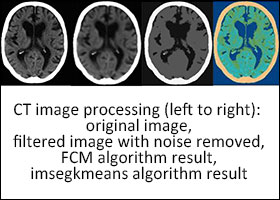Applications of Fractal Analysis in Brain Images Interpretation
A special issue of Brain Sciences (ISSN 2076-3425). This special issue belongs to the section "Neurotechnology and Neuroimaging".
Deadline for manuscript submissions: closed (20 December 2020) | Viewed by 9738

Special Issue Editor
2. Academy of Romanian Scientists, 050094 Bucharest, Romania
Interests: gels; mathematical physics; biophysical modelling; complex systems; nonlinear dynamics; chaos theory; fractal analysis; image processing
Special Issues, Collections and Topics in MDPI journals
Special Issue Information
In the last decade, constant progress in neuroimaging has graced us with an additional type of illustration that is frequently used as scientific real evidence in discovering and interpreting the evolution of specific diseases. Therefore, brain images have epistemically special significance, while they are also liable to be viewed as akin to photographs of brain activity itself.
As a result of this, it is necessary to develop algorithms based on recognized methods. The proposed algorithms will be used in image processing in brain computed tomography image analysis.
Image fabrication and obtaining results are possible because some components of the brain, such as the blood vessel network or the neural network, have a fractal arrangement, which makes it easy to analyze their structure in order to provide predictions or treatments as accurately as possible to patients afflicted with a serious brain disease.
In recent years, approaches in this category have demonstrated admirable outcomes, superior to those obtained by standard methods in different areas. Today, specialized investigators are trying different new techniques for in-depth analysis to enhance the performance of detection systems in neoplasm screening by computed tomography, including both identification and localization of abnormalities known as mini-tumors in the medical field (even though they can be about the size of some pixels), which some inexperienced radiologists may fail to observe.
Identifying malignant nodosities or cerebral cancer constituents from computerized tomography exploration is a difficult load and time-consuming for specialist radiology physicians, such as liver doctors, lung doctors or neurologists. The same thing also happens when examining images obtained through the magnetic resonance (MR) technique.
Very rapid diagnosis of cancer constituents by screening allows immediate medical interventions to reduce mortality rate. Fractal analysis of medical images may be useful for this purpose. Calculations of the fractal dimensions, the Hurst exponent, and lacunarity of pathological and healthy tissue samples can be performed using qualified methods.
Further, there is accumulating evidence that brain magnetic resonance imaging may be useful in staging and monitoring disease progression (staging biomarker), and also possibly as a means to monitor pathophysiological aspects of disease and associated response to treatments, i.e., theranostic marker. More so, magnetic resonance imaging has the potential to serve as a biomarker for Parkinson's and Alzheimers diseases.
In conjunction, these investigations will contribute to our current understanding of neurological disorders and their evolution in particular, or neuroscience in general.
To facilitate this service immediately, the aforementioned techniques and methods highlighted should be refined in the proposed papers submitted to the Special Issue, which aims to bring together cutting-edge research on the brain advanced image processing, as well as self-representation in brain research, in a quantitative rather than qualitative manner.
Finally, we will accept scientifically rigorous and novel original papers about the processes discussed above and neuroimaging data, as well as reviews and meta-analyses in the field.
Prof. Dr. Viorel-Puiu Paun
Guest Editor
Manuscript Submission Information
Manuscripts should be submitted online at www.mdpi.com by registering and logging in to this website. Once you are registered, click here to go to the submission form. Manuscripts can be submitted until the deadline. All submissions that pass pre-check are peer-reviewed. Accepted papers will be published continuously in the journal (as soon as accepted) and will be listed together on the special issue website. Research articles, review articles as well as short communications are invited. For planned papers, a title and short abstract (about 100 words) can be sent to the Editorial Office for announcement on this website.
Submitted manuscripts should not have been published previously, nor be under consideration for publication elsewhere (except conference proceedings papers). All manuscripts are thoroughly refereed through a single-blind peer-review process. A guide for authors and other relevant information for submission of manuscripts is available on the Instructions for Authors page. Brain Sciences is an international peer-reviewed open access monthly journal published by MDPI.
Please visit the Instructions for Authors page before submitting a manuscript. The Article Processing Charge (APC) for publication in this open access journal is 2200 CHF (Swiss Francs). Submitted papers should be well formatted and use good English. Authors may use MDPI's English editing service prior to publication or during author revisions.
Keywords
- brain images
- computed tomography
- radiology
- magnetic resonance
- fractal analysis
- multifractal analysis
- fractal dimension
- lacunarity
- box counting algorithm
- complex systems
- time scale
- pattern recognition
- brain disease
- neurological disorders
- biomarker for Parkinson’s and Alzheimer’s diseases






